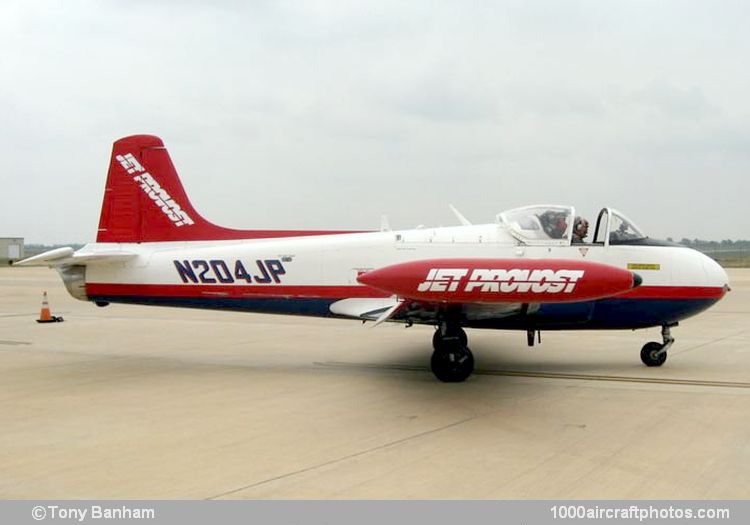06/30/2011. Remarks by Johan Visschedijk: "Hunting was formed as the Percival Aircraft Company in 1932. It was re-organized as Percival Aircraft Ltd. in 1937, and the works were moved from Gravesend, England, to Luton. In 1944 the company became part of the Hunting Group and a branch office was opened at Toronto, Canada, in 1946. The name was changed to Hunting Percival Aircraft, Ltd. in 1954 and to Hunting Aircraft Ltd. in 1957. A controlling interest in Hunting Aircraft, Ltd. was acquired by British Aircraft Corporation (BAC) in September, 1960. On January 1, 1964, BAC acquired the remaining shares and the name Hunting Aircraft Ltd. was dropped.
The all-metal structure Jet Provost, which was developed for the RAF as its standard two-seat primary and basic jet trainer, was a direct descendent of the Leonides piston-engine powered Provost in that the same overall geometry was retained wherever possible in order to reproduce the good handling characteristics of the earlier aircraft. The following versions have appeared under the Hunting name:
P.84 Jet Provost T.Mk.1. One 1,640 lb (745 kg) st Bristol Siddeley Viper 101 turbojet. Batch of ten built to Ministry of Supply (MoS) contract, plus one Hunting demonstrator. First flown June 26, 1954. Service trials began at Central Flying School in July, 1955 and experimental training course at Hullavington in August, 1955. One of the MoS batch completed as T.Mk.2.
P.84 Jet Provost T.Mk.2. Differed from T.Mk.1 in having 1,750 lb (795 kg) st Viper 102 turbojet, shorter landing gear, and hydraulic instead of pneumatic services. First flown September 1, 1955. One MoS prototype and three Hunting demonstrators, of which one went to the RAAF for evaluation, one was used for armament trials and one (G-AOUS) was re-engined with a 2,500 lb (1,134 kg) st Viper 201 turbojet.
P.84 Jet Provost T.Mk.3. Similar to T.Mk.2, but with one-piece molded windscreen, Martin-Baker lightweight ejection seats, wing tip fuel tanks and detail refinements. First flown June 22, 1958 and first deliveries to RAF June 26, 1959.
P.84 Jet Provost T.Mk.4. Similar to T.Mk.3, but with 2,500 lb (1,134 kg) st Viper Mk. 202 turbojet and detail changes. The T.Mk.4 was developed to meet the RAF requirement to extend the basic syllabus and thus economize in the use of the more expensive advanced trainer. Deliveries began November, 1961.
P.84 Jet Provost T.Mk.51. Armed export version of T.Mk.3, with two 0.303 in (7.7 mm) machine guns in engine intake walls, gun camera in nose and under-wing attachments for rockets or small bombs. Twelve delivered for Royal Ceylon AF, four for the Sudan AF and six for the Kuwait AF.
P.84 Jet Provost T.Mk.52. Armed export version of T.Mk.4, with same operationa1 equipment as T.Mk.51. Delivered to Sudan AF and Venezuelan AF (15).
The description and specification which follow refer to the Jet Provost T.Mk.4.
Wings: Cantilever low-wing monoplane. Wing section NACA 23015 (modified) at root, NACA 4412 (modified) at tip. Aspect ratio 5.84. Chord 7 ft 8 in (2.33 m) at root, 4 ft 4 in (1.31 m) at tip. Dihedral 6°. Incidence 3° at root, 0° at tip. Metal-covered ailerons, with trim tabs. Slotted flaps. Air brakes on wings at rear spar position ahead of flaps. Both air brakes and flaps were hydraulically-operated. Total aileron area 19.06 sq.ft (1.77 sq.m). Total flap area 24.8 sq.ft (2.30 sq.m). Gross wing area 213.7 sq.ft (19.80 sq.m).
Tail unit: Cantilever monoplane type. One-piece tail plane, interchangeable elevators, fin and rudder. Trim and balance tabs in elevators, combined trim and balance tab in rudder. Span of tail plane 13 ft 6 in (4.1 m).
Landing gear: Retractable nose wheel type. Dowty oleo-pneumatic shock-absorbers. Pneumatic retraction. Dunlop wheels and tires. Main wheel tires size 21 x 6.75-9, pressure 58 lb/sq.in (4.1 kg/sq.cm). nose wheel tire size 6.00 x 4, pressure 65 lb/sq.in (4.6 kg/sq.cm). Dunlop hydraulic disc-brakes. Wheel base 9 ft 7.4 in (2.93 m). Track 10 ft 8.9 in. (3.27 m).
Power plant: One Bristol Siddeley Viper turbojet engine in fuselage aft of cockpit. "Elephant-ear" intakes on each side of forward fuselage and jet exit at rear of fuselage aft of tail plane. Normal internal capacity (three tanks in each wing) 219 gal (827 l). Two 58 gal (218 l) wing tip tanks may be fitted to order. Oil capacity 2.1 gal (8 l).
Accommodation: Enclosed cockpit in front of leading-ede of wings seating two side-by-side in air-conditioned cockpit with dual controls. Martin-Baker Mk.4P lightweight ejector seats. Single centrally-placed blind-flying panel. Manually-operated rearward sliding jettisonable canopy. Oxygen automatically turned on at 8,000 ft (2,440 m). RAF aircraft fitted with UHF radio and Rebecca Mk.8. Alternatives include VHF radio and radio-compass.
Armament: Provision for an 0.303 in (7.7 mm) machine gun in the base of each engine air intake, with 600 rounds per gun, a cine-camera gun in nose and two standard reflector sights. Additional alternative weapon loads include an under-fuselage pack of two 0.50 in (12.7 mm) guns with 100 rounds per gun, or, on under-wing attachments, eighteen Sura Mk.3 rockets, six 60 lb 27 kg) rockets, twelve 25 lb (11.4 kg) rockets, twelve 3.15 in (8 cm) Oerlikon rockets, eight 25 lb (11.4 kg) bombs or two 100 lb (39 kg) bombs.
The pictured aircraft was delivered to the RAF on August 29, 1963 with serial XR701, and eventually became a ground-instructional airframe, coded "9025M". Struck off charge it was sold to Everett Aero, Sproughton, Ipswich, UK in April 1993, and resold to the USA, where the registration N8272W reportedly was reserved but not taken up. Subsequently it was reregistered N204JP and the aircraft received a CofA on August 5, 2000. On April 5, 2002 it was registered to Richard Griggs at Cheraw, South Carolina, USA, and on March 8, 2011 to its present owner, RAF Linton-Texas Squadron LLC. of Houston, Texas."
